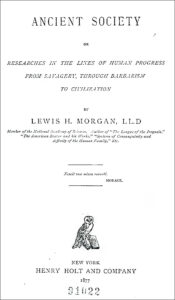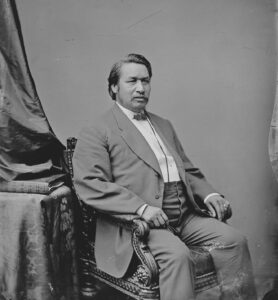Morgan’s Life and Legacy
A Scholar and Scientist
Morgan’s interest in the historical traditions of Native Americans grew out of his youthful participation in a literary fraternity that he organized as “The Grand Order of the Iroquois.” His first book, The League of the Ho-dé-no-sau-nee, or Iroquois (1851), marks the beginning of American anthropology. Although flawed, the book is notable for its attempt to understand Haudenosaunee social and political institutions in their own distinctive cultural terms. It was written with the assistance of Ely S. Parker and Caroline G. Parker, prominent members of a Tonawanda Seneca family that befriended Morgan and facilitated his field research.
Ely Samuel Parker (born Hasanoanda, later known as Donehogawa) was a Tonawanda Seneca Sachem, civil engineer, and attorney. He served as a lieutenant colonel and military secretary to Ulysses Grant during the American Civil War and later became the first Native American to serve as commissioner of Indian Affairs.
Morgan’s later publications made substantial and enduring contributions to subjects as diverse as the study of domestic architecture and the natural history of beavers. His landmark 1871 book, Systems of Consanguinity and Affinity of the Human Family, initiated the comparative study of kinship as a central anthropological concern. Morgan’s collections of Iroquois material culture, now housed at museums in Albany and Rochester, continue to provide a touchstone for contemporary Haudenosaunee artists.

Title Page of Ancient Society (1877). In Ancient Society Lewis Henry Morgan reconstructed the evolution of human society. He argued that each stage of development (savagery, barbarism, and civilization) was tied to a technological advance. Courtesy of HathiTrust Digital Library.
A Man of his Time
Despite his scholarly insights and his occasional advocacy for the interests of the Tonawanda Senecas and other Native Americans, Morgan failed to overcome the racial assumptions and prejudices of the settler colonial society in which he lived. He imagined assimilation to white American society and eventual citizenship, rather than cultural autonomy and political sovereignty, as the future for Native people and nations.
Morgan’s 1877 book, Ancient Society, charted a single path of progress for all human societies that led from “savagery” to “barbarism” to “civilization.” For Morgan, as for many other social thinkers in his day, Indigenous peoples such as the Onondawaga (Seneca) represented earlier phases of history through which his own Euro-American society had evolved on the way to “civilization.” Morgan accordingly thought of his task as documenting the lifeways of Indigenous peoples before they vanished—a fate that he wrongly believed to be inevitable.
A Rochester Citizen
Morgan moved to Rochester in 1844. He lived in the Third Ward with his wife, Mary E. Steele, and family until his death in 1881. Morgan was elected to both the New York State Assembly (1861) and New York State Senate (1868-1869). He lobbied for improvements in the Erie Canal in order to enhance commerce, and he amassed a sizeable fortune through his work as a corporate lawyer and his investments in railroads and iron smelting in Michigan’s Upper Peninsula. Morgan also co-founded and led “The Club,” a fraternal literary society that brought together many of Rochester’s leading intellectuals and professionals.
A firm believer in democracy and the power of education, Morgan also favored greater equality of the sexes. He bequeathed his estate and library to the University of Rochester for the specific purpose of making available to women the same higher education already available to men. His family mausoleum is in Mt. Hope Cemetery.


